|
|
| Home - Software M&A Review - Nov 06 Issue |
Software M&A – A Buoyed Q3
continued... page 3 |
As in quarters past, software led all other industry sectors in 3Q06 deal activity. Though the total number of software M&A transactions remained relatively flat compared to 1Q06 and 2Q06 (Figure 14), there was an astonishing $30.5 billion spent on software M&A transactions in 3Q06 (Figure 15), more than the entire first half of 2006 ($25.9 billion). The quarter’s impressive spend total was boosted by five mega-deals, each with an equity value purchase price of $1 billion or more.
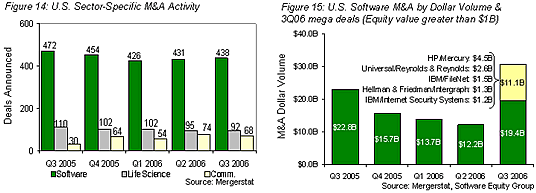
Deal currency in 3Q06 strongly favored cash over stock, reflecting sellers’ continuing uneasiness with erratic tech sector market performance and buyers’ burgeoning cash reserves. 3Q06 saw the highest percentage of all cash deals than any quarter in the past four years. All cash deals represented 82% of 3Q06 software and technology sector M&A transactions, an 11% increase over 2Q06 and an 8% increase over 3Q05, while all stock transactions comprised only 2% of 3Q06’s deals, down 2% from the prior quarter (Figure 16).
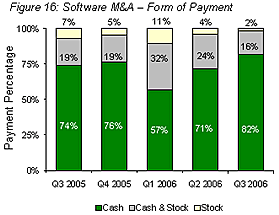
Only 16% of software M&A transactions in 3Q06 featured a combination of cash and stock, down 8% from 2Q06 and 3% from 3Q05.
During the past two years, approximately 34% of all software industry acquirers were private equity firms and private companies. While the percentage of private buyers dipped in 3Q06, the size of their acquisitions increased, and will most likely increase further in 4Q06. In 3Q06, private buyers accounted for 28% of all software M&A transactions, a marked decrease from 2Q06’s 33% and 3Q05’s 42% (Figure 17). Still, venture capitalists, private equity firms, and venture-backed private companies remained active, searching diligently for private and public software company buyouts that could satisfy their investment criteria (Figure 18).
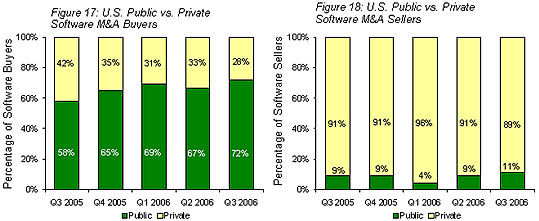
Typically these financial buyers sought to acquire software companies they could leverage with significant debt and advisory fees, a process politely known as dividend recapitalization. In most cases, the targets market were ‘platform’ software companies with revenue of $100 million or more, significant and sustainable recurring revenue and profits, an entrenched, dominant and defensible market position, and a potential for rapid and sizable inorganic growth. In other cases, the targets were tuck-in acquisitions for existing portfolio platform companies.
The median valuation of software industry M&A transactions (based on TTM revenue and the seller’s equity value) in 3Q06 was 2.7x, on par with 3Q05 (2.7x) and a marked increase over 2Q06 (2.3x), which we indicated last quarter was an aberration (Figure 19).
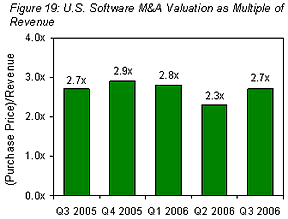
However, we once again caution against using the median deal multiple (based on trailing twelve months revenue, or TTM) as anything other than a point of reference – and a potentially misleading one, at that.
In Figure 20, we’ve separated all software industry M&A activity for the trailing twelve months into software product categories as a first step to providing greater insight into software company M&A valuations. Of the 600 software deals we analyzed, a remarkable 29.7% of the sellers were vertical market solution providers (marked in dark green). The most active vertical markets in 3Q06 for software M&A remained healthcare and financial services, a trend highlighted in past reports. We expect vertical transactions as a percentage of total deal activity to increase further, as both vertically focused set buyers and horizontal buyers find value and leverage in best of breed vertical niche solutions.
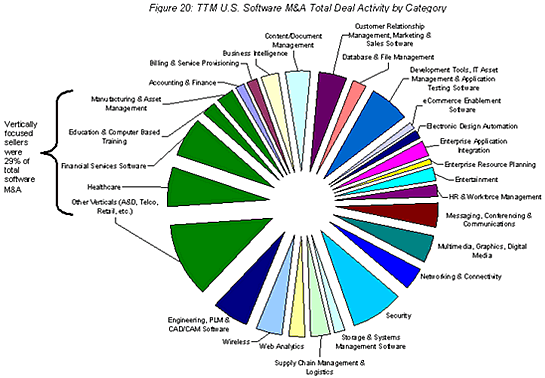
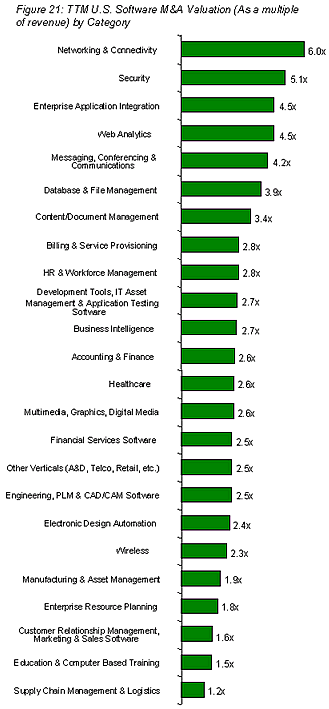 Among horizontal product categories, security has been one of the most active software M&A categories for the last two years, representing 10.5% of all software M&A. Large enterprise software vendors (IBM/Internet Security Systems), private equity firms (Francisco/WatchGuard), networking and storage vendors (Cisco/Meetinghouse and EMC/RSA), and other security software vendors (Secure Computing/CipherTrust, Sonicwall/MailFrontier), have all scurried to add vital security features to their existing product offerings. Not to be outdone, the category consisting of developer tools/IT asset management/application testing has accounted for 6.2% of total software M&A, and should grow as large enterprises migrate to SOA. While ERP may seem like a relatively small percentage of total software M&A activity, note that many of the sellers that could have been included in ERP were instead categorized as vertical (e.g. Manufacturing, Healthcare, etc.).
Among horizontal product categories, security has been one of the most active software M&A categories for the last two years, representing 10.5% of all software M&A. Large enterprise software vendors (IBM/Internet Security Systems), private equity firms (Francisco/WatchGuard), networking and storage vendors (Cisco/Meetinghouse and EMC/RSA), and other security software vendors (Secure Computing/CipherTrust, Sonicwall/MailFrontier), have all scurried to add vital security features to their existing product offerings. Not to be outdone, the category consisting of developer tools/IT asset management/application testing has accounted for 6.2% of total software M&A, and should grow as large enterprises migrate to SOA. While ERP may seem like a relatively small percentage of total software M&A activity, note that many of the sellers that could have been included in ERP were instead categorized as vertical (e.g. Manufacturing, Healthcare, etc.).
After scrutinizing Figure 21, we wondered if there was a meaningful correlation between a software product category’s median M&A valuation and category deal volume. Did the most active sectors yield the highest multiples? They did not. Our analysis produced a statistically insignificant R2 of 0.043. ‘Location’ remained the single most important software M&A valuation driver in 3Q06. Valuations ranged from 6.0x for networking & systems management software sellers (CA/Wily, Citrix/Orbital) to 1.2x for supply chain management sellers (JDA/Manugistics, Illinois Tool Works/Click Commerce) (Figure 21). Enterprise Application Integration (EAI) sellers (BEA/Fuego, Progress/NEON, RedHat/JBoss) received a healthy premium compared to the rest of the software M&A universe, thanks in large part to increasing migration to SOA.
Mergers and Acquisitions: The Drivers
Product Enhancement
The majority of buyers in the second quarter sought to enhance their product suites by acquiring companies with complementary products and enabling technologies targeting the same markets. Typically, these transactions, which we characterize as ‘product extensions’, are considered by the buyer to be highly strategic, and valuations tend to reflect that.
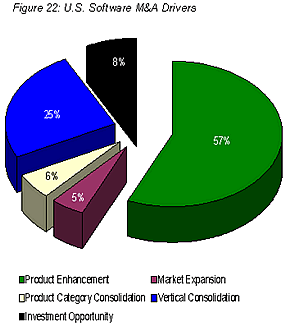 Product extension deals accounted for 57% of the software transactions we analyzed (Figure 22). Sellers whose offerings were deemed vital to improving the functionality or performance of the buyer’s suite commanded a 3.9x TTM revenue multiple in 3Q06. Representative transactions in this category included Citrix’s highly anticipated purchase of a WAN optimization company (Orbital Data) to add to its application-networking portfolio, and Salesforce.com’s acquisition of Kieden, an AppExchange application that connects Salesforce.com’s CRM application to a customer’s Google AdWords account. Similarly, IBM, a frequent and disciplined buyer, deviated this quarter from its infrastructure and middleware only acquisition strategy, buying application vendors FileNet and MRO as well as infrastructure plays Internet Security Systems and Webify; and webMethods acquired Infravio, a SOA registry and governance solution, which adds necessary functionality to Webmethods’ business integration platform.
Product extension deals accounted for 57% of the software transactions we analyzed (Figure 22). Sellers whose offerings were deemed vital to improving the functionality or performance of the buyer’s suite commanded a 3.9x TTM revenue multiple in 3Q06. Representative transactions in this category included Citrix’s highly anticipated purchase of a WAN optimization company (Orbital Data) to add to its application-networking portfolio, and Salesforce.com’s acquisition of Kieden, an AppExchange application that connects Salesforce.com’s CRM application to a customer’s Google AdWords account. Similarly, IBM, a frequent and disciplined buyer, deviated this quarter from its infrastructure and middleware only acquisition strategy, buying application vendors FileNet and MRO as well as infrastructure plays Internet Security Systems and Webify; and webMethods acquired Infravio, a SOA registry and governance solution, which adds necessary functionality to Webmethods’ business integration platform.
We expect product extension deals will continue to dominate the software M&A landscape in the fourth quarter, as it has in years past.
Market Expansion
Historically, we’ve defined Market Expansion transactions to include buyers that acquire software companies in entirely new product categories, new territories or new vertical markets. This quarter we extend the definition of Market Expansion deals to include companies acquired by buyers who sought to bolster their vertical or geographic expertise. These buyers may already market to a particular vertical or geography, but lack the domain knowledge vertical customers insist upon which the seller can provide. This M&A driver category is still a minor contributor to total software M&A, representing 5% of aggregate deal activity. Representative market expansion transactions this quarter include: Illinois Tool Works (ITL), a $13.5 billion provider of tools (nail guns, industrial adhesives, etc.), which made its initial foray into software by purchasing supply chain and collaboration management software provider Click Commerce. Other market expansion transactions included Lawson Software’s acquisition of Competency Assessment Solutions to strengthen its position in healthcare; and The Thomson Corporation’s acquisition of domain expertise in both the legal vertical and the educational vertical by acquiring LiveNote and ScholarOne, respectively.
Vertical Markets
Vertical software company buyers in 3Q06 continued to acquire smaller ISVs serving the same vertical markets, accounting for 25% of all 3Q06 software M&A activity. It now appears likely 2006 will set a new record for vertical market software transactions as a percent of total. While healthcare software companies have historically dominated this category in the past, M&A activity this quarter was strong across multiple vertical markets. Vertical market software deals in 3Q06 spanned healthcare insurance (Trizetto/QCSI), financial services (CCH/Taxwise), telecommunications (Comverse/Netonomy), aerospace and defense (Rockwell Collins/Anzus) and hospitality (Gladstone/London Systems).
Product Category Consolidation
While certain industry pundits continue to hype the consolidation wave sweeping the software sector, acquisitions of competitors by their software company rivals to gain market share and eliminate a competitor accounted for only 6% of 3Q06 software deals, down from the 11% average of the last two years. The two most notable consolidation plays this quarter were Open Text’s acquisition of Hummingbird and privately held Universal Computer System’s $2.8 billion acquisition of Reynolds and Reynolds.
Investment Acquisitions
Although some 28% of 3Q06’s total software M&A transactions were private buyers, most were venture-backed private software companies spending VC and private equity investor cash. However, in eight percent of software M&A transactions in 3Q06 VCs and private equity firms, awash in cash and under growing pressure to invest it, acquired directly – opting primarily for large, established and relatively safe companies. The most notable deal within this category was Hellman & Friedman’s acquisition of Intergraph, provider of GIS and design software; Francisco Partners acquisition of Watchguard; Thoma Cressy Equity Partners’ acquisition of Embarcadero Technologies; and Bain Capital’s acquisition of Applied Systems.
Software Equity Group, L.L.C. (SEG), a mergers and acquisitions advisory firm serving the software, life science, and technology sectors, prepared this report. SEG is solely responsible for its content. This material is based on data obtained from sources we deem to be reliable; it is not guaranteed as to its accuracy and does not purport to be complete. This information is not to be used as the primary basis of investment decisions. For more, please visit www.softwareequity.com, or phone (858) 509-2800.
 

|
|


|

